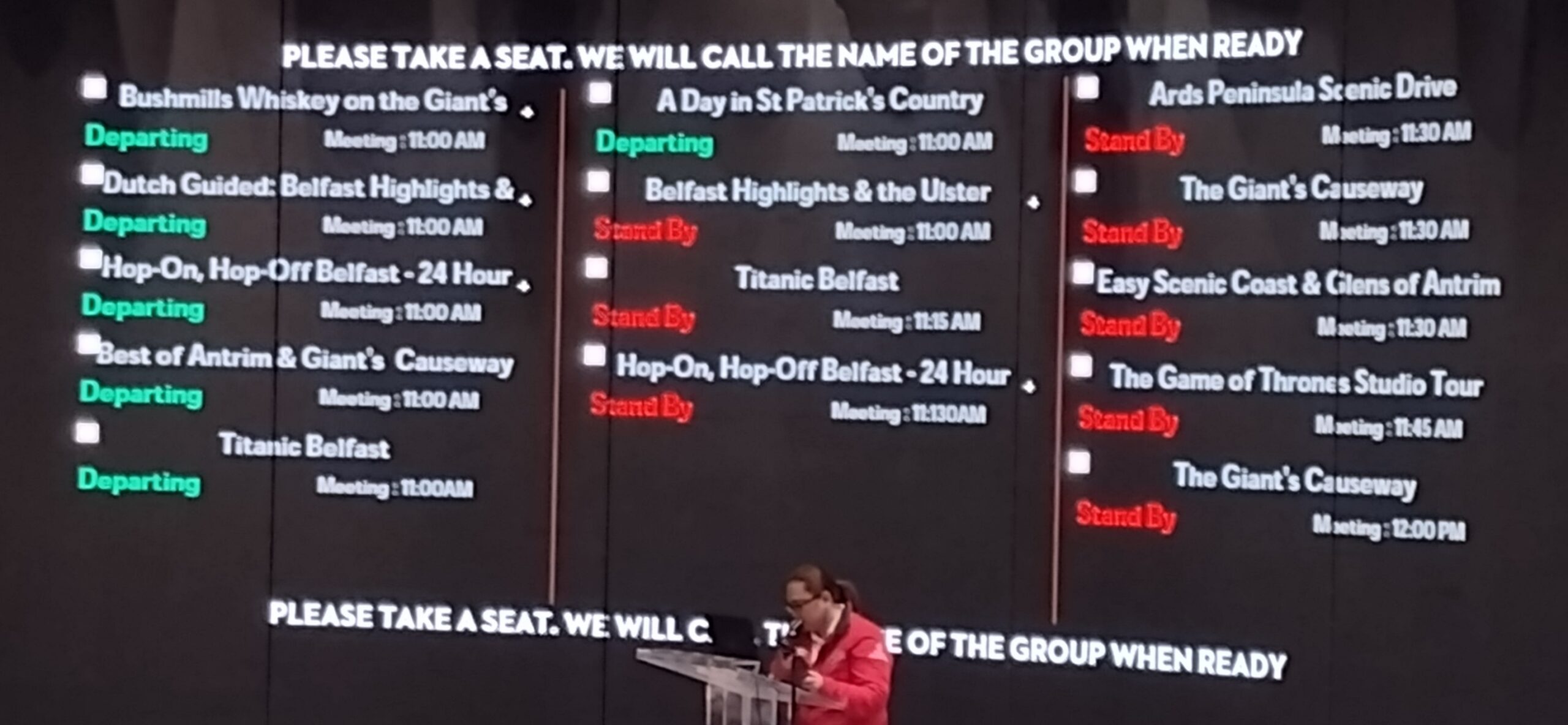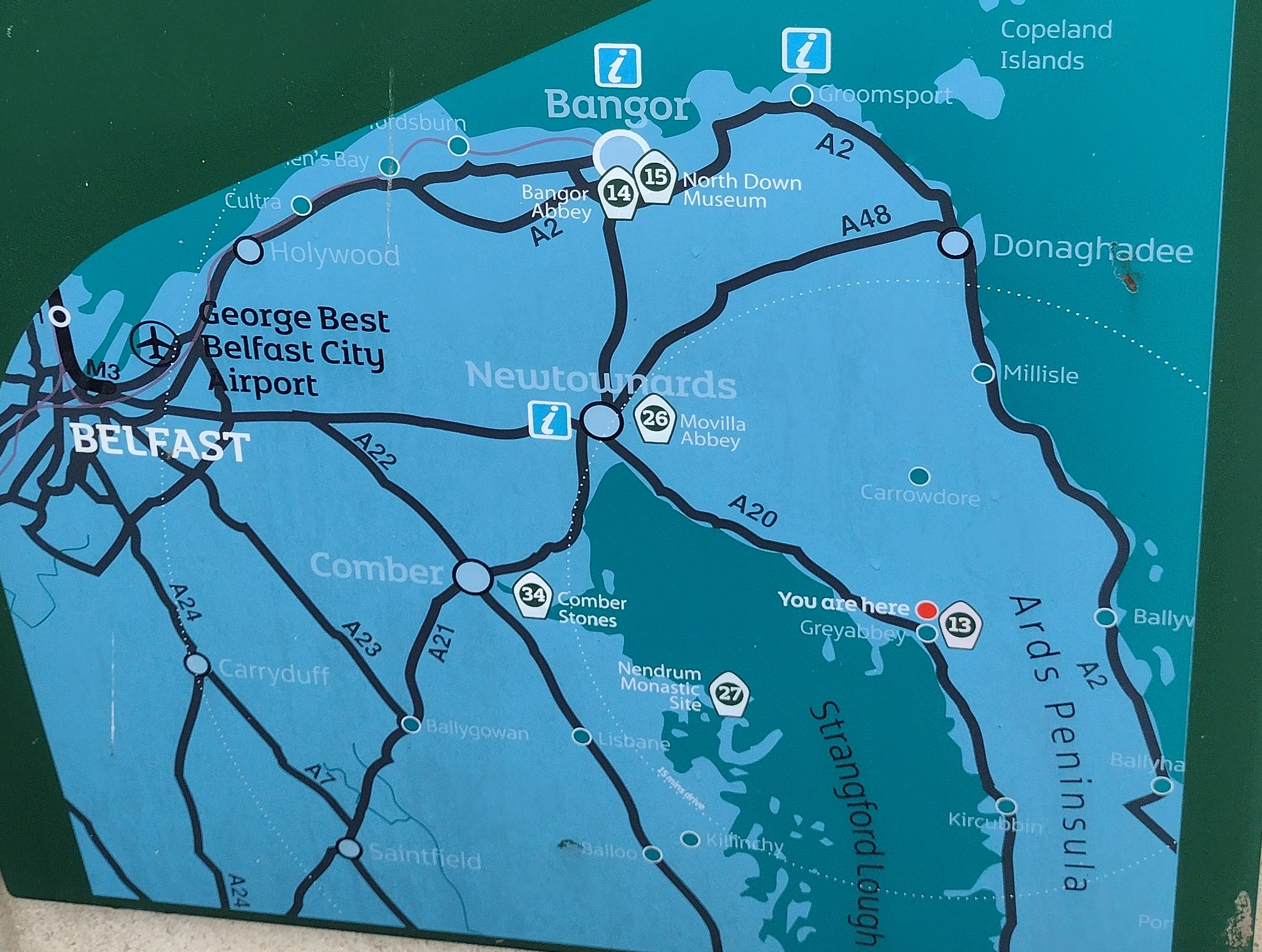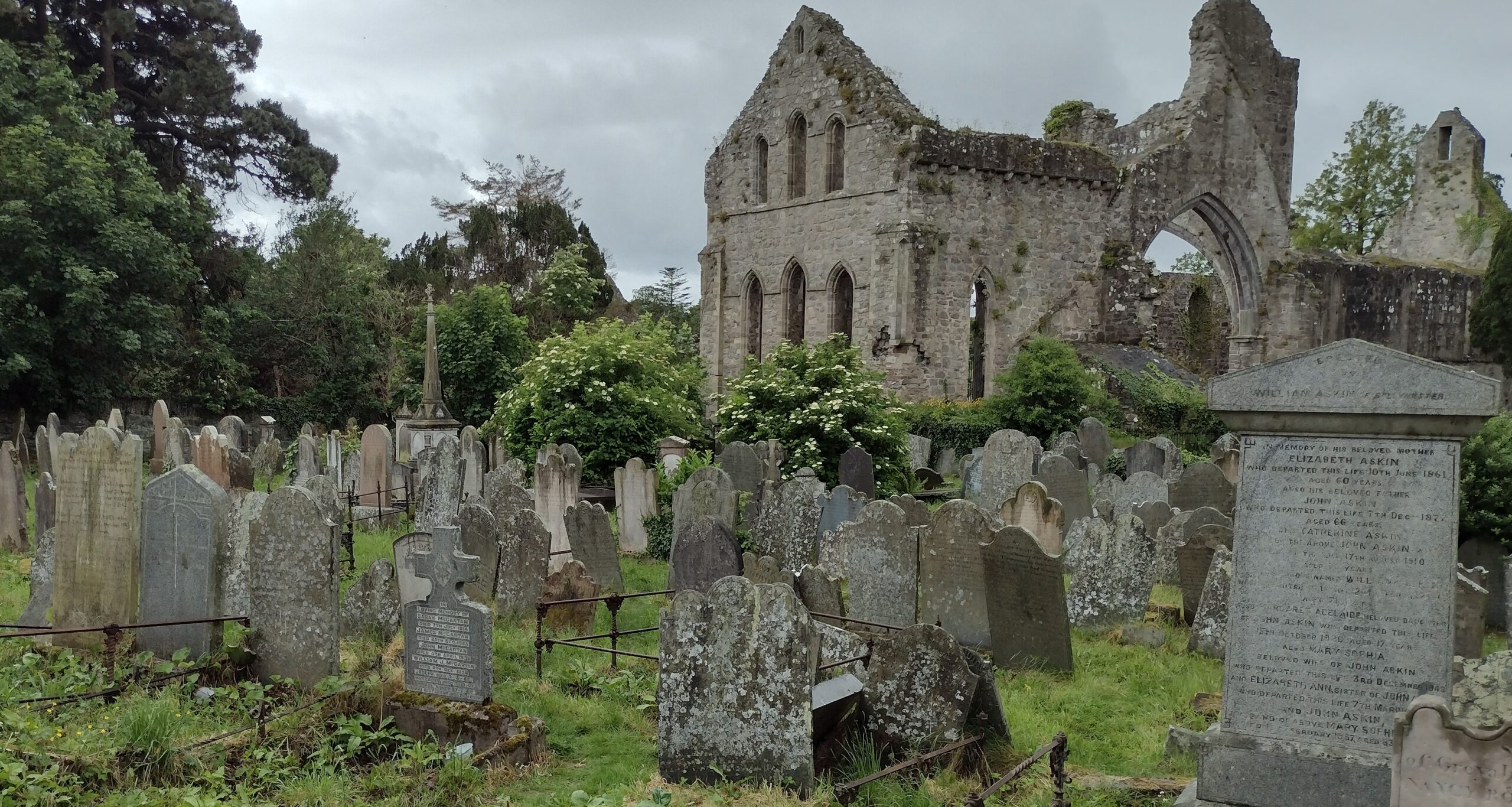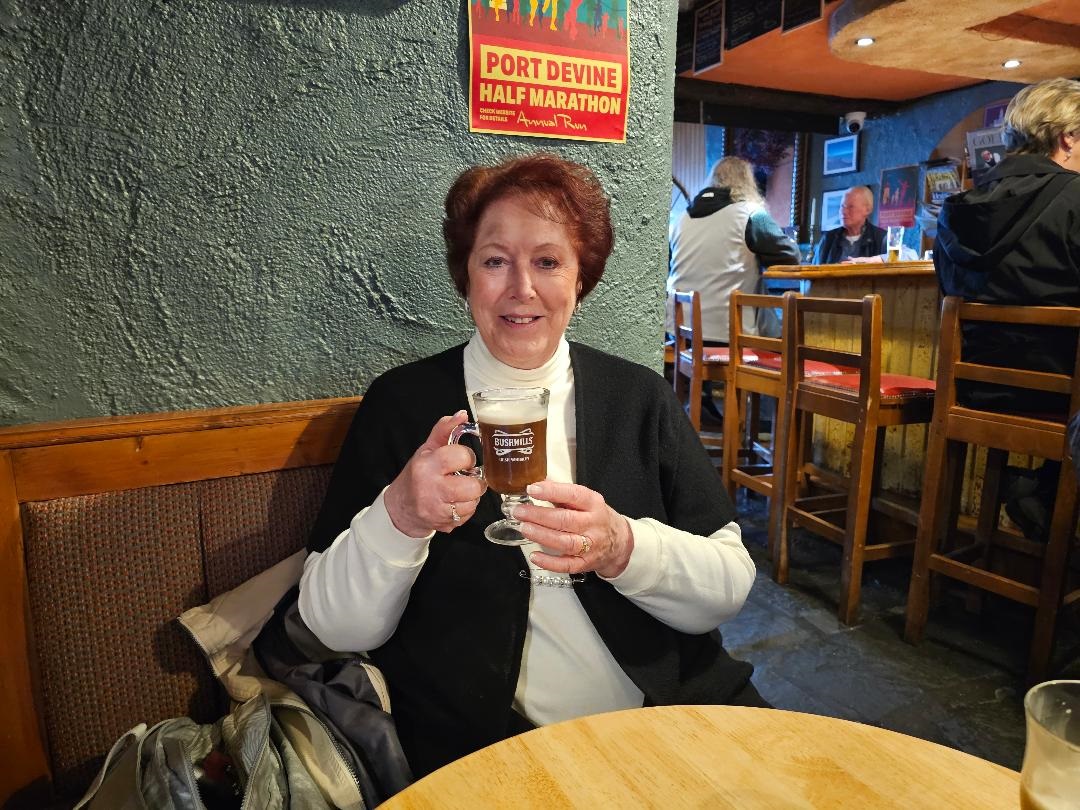Some people think that Glasgow is a sea port but it is not. It is a river port. It is located inland on the river Clyde. This is an estuary river (think the shape of a wedge, wide at open sea side and narrow at Glasgow side) and thus it has a large tidal range. The one foot height difference at the sea end of the river becomes up to 12 feet once the water is pushed all the way up the ever smaller river. So for shipping that can reach Glasgow, there is a King George dock that shields ships visiting from having the go up and down too much. Hence container ships and larger cruise ships have to dock at Greenock. Around the Greenock were once the old shipyards and steel works that churned out the cargo, passenger ships and navy ships that served the British Empire. Famous ships such as the Queen Mary (I), Queen Elizabeth (I&II), Lusitania, etc. etc. came from here. That is all gone and the shipyards have been replaced with housing and parks. The grass and other vegetation is now covering centuries of industry (and also the pollution that came with it). Glasgow now makes its money from the Service Industry and related.
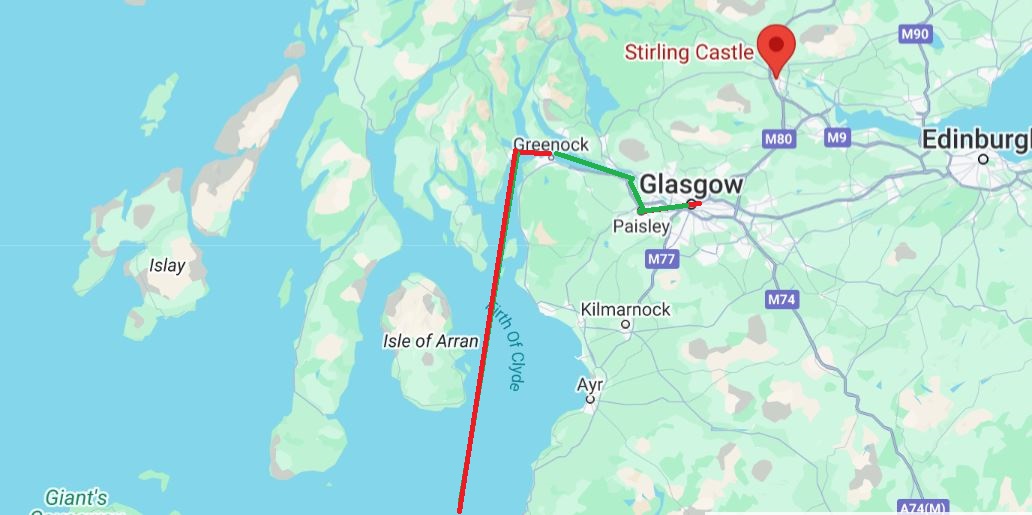
Overview of the area (thank you google) The red line is the route in and out of the River Clyde and the green line is the river Clyde up to Glasgow. During WWII Greenock was the place were the convoys came in from America, as it was a sheltered area that could handle big fleets. Falkirk is slightly to the South East of Stirling Castle.
We had decided for today to take the day tour to the town of Stirling for free time and the Falkirk wheel which is a sort of lift that raises narrow boats between one canal and another canal that are 135 feet apart in elevation. It is the only one in the world and thus attracted my interest. It started with an hour long scenic coach drive down to the town of Stirling. Although better said, a drive up, as Stirling is located an hours drive North of Glasgow. Although most of it was on the motor way, via the Glasgow ring road, it was still very scenic with extensive meadows on either side of the road and lots of old & new houses and cottages zooming by.
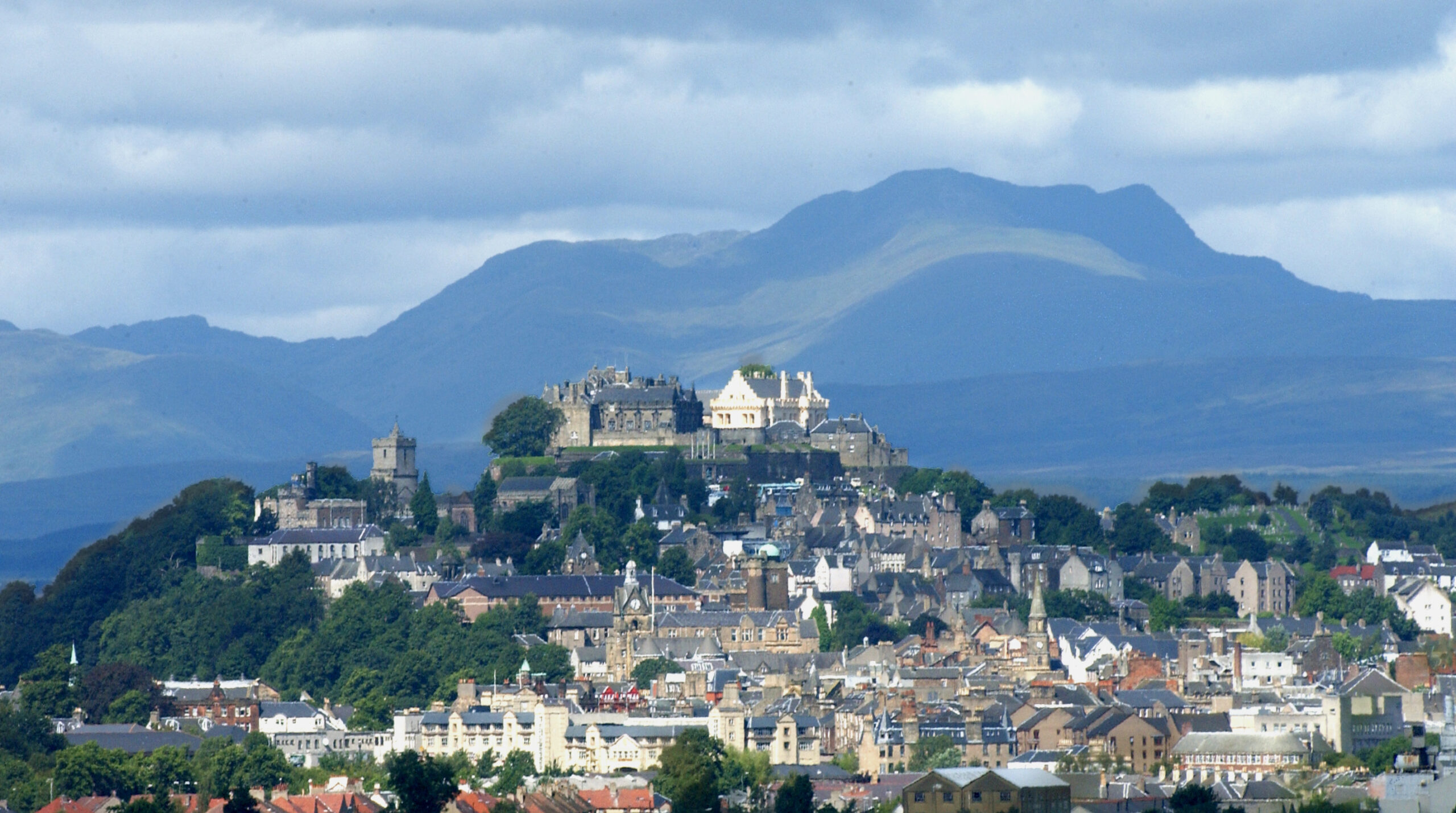
Scenic view of Stirling with the Castle (courtesy Visit Scotland)
The town of Stirling itself was “on your own” with 3 hours free time to walk around, go to the castle, visit a museum or just enjoy a Sunday morning in Scotland (which for shopping starts around noon time). It only drizzled a little bit. I have now figured out with the weather that in my home town (East side of England) that when it gives 20% chance of rain that you have indeed 80% chance that is is dry. But here on the west coast of Scotland and the island of Ireland, when the prediction is 20% of rain, then you will get that 20%. So a small wind-defying umbrella is now standard equipment for going out.
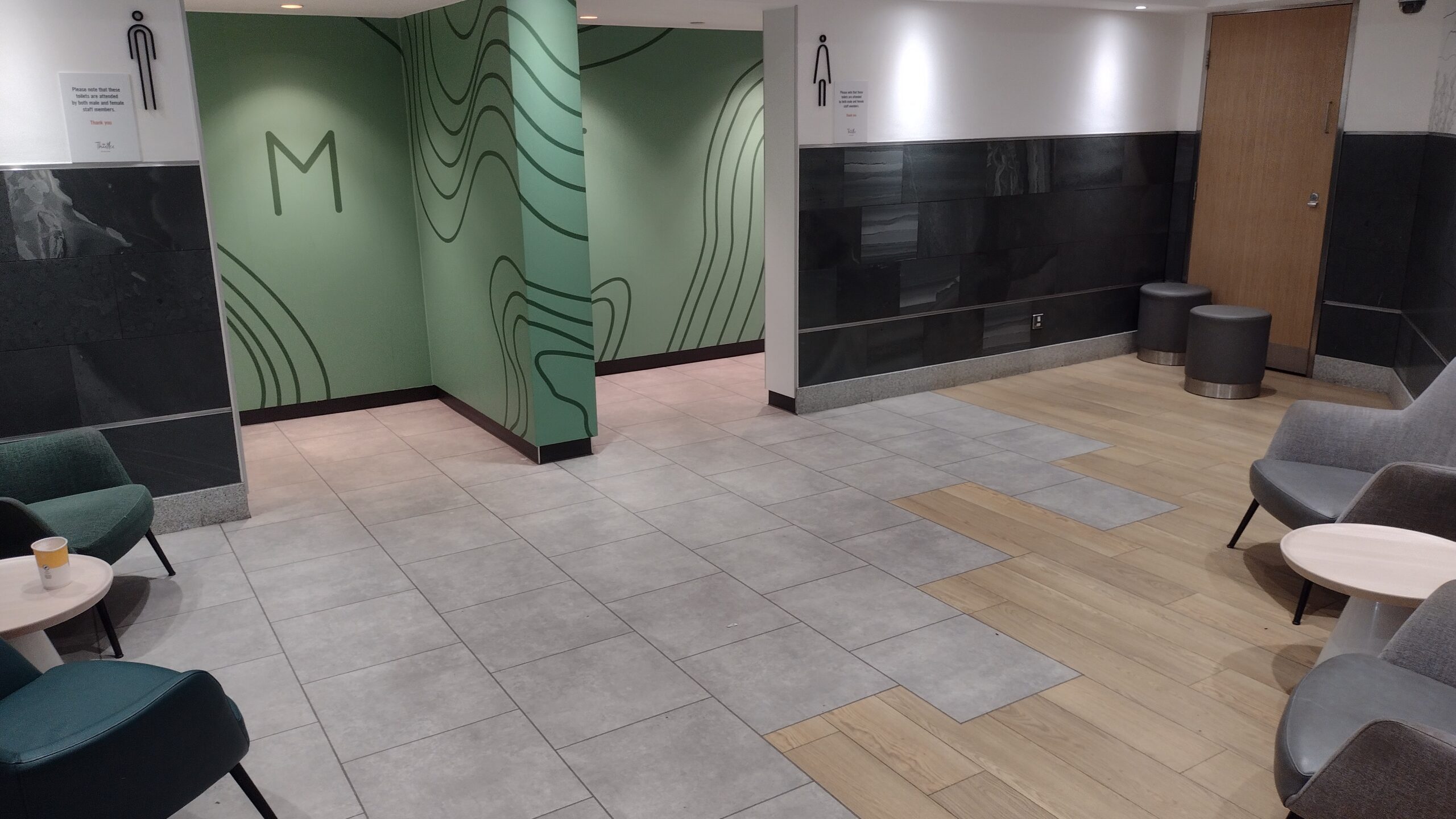
The public toilets waiting in the local shopping center
What was so special about Stirling? It was only granted city rights in 2002 but was the nations capital in the 12th. century. Hence the presence of Stirling Castle, which housed among others Mary Queen of Scots. The company has a separate tours going there but some of our bus passengers also hiked up the hill to have a look. I have seen too many Castles in my life already (although I love them) so I was not that bothered. Plus we have Norwich Castle on our doorstep and that is hard to beat anyway. No, what made the biggest impression ? The public toilets. I have never seen them so clean and with a waiting area with nice chairs. No impatient blokes hanging around waiting for their better half to come out, no, some nice seats to contemplate life while her ladyship is going about her business.
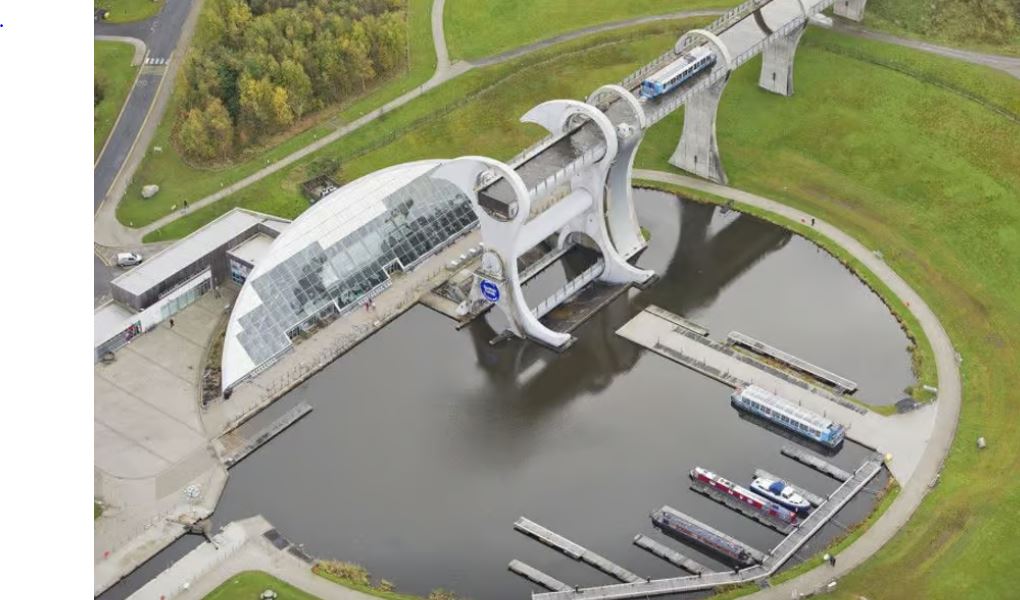
Overview of the Falkirk wheel. To the lower left the entrance to the Fife & Clyde Canal. Left the visitor center and then the boat lift with the exit going towards the tunnel and from there to the connection with the Union Canal.
And so after walking through the very nice streets, visiting all the Charity Shops (I am always on the hunt for un-expected nautical book finds) and eating scones, we went back on the bus and drove for 30 minutes to Falkirk. This was the main reason for me to be interested in doing the tour. Falkirk has been serviced since the 19th. century by two canals, The Union Canal on the higher level coming from England and the Forth & Clyde canal 135 feet down on the lower level. To connect the two there was an extensive lock system that took about 6 hours for a barge to get through. When the railways took over, the canals fell in disrepair but after the 1970’s there was a resurgence in interests and in the next 30 years (and it is still going on) many of the canals were repaired and brought life to the areas by means of canal trips in narrow boats. It has brought a new lease of life to some deprived areas.
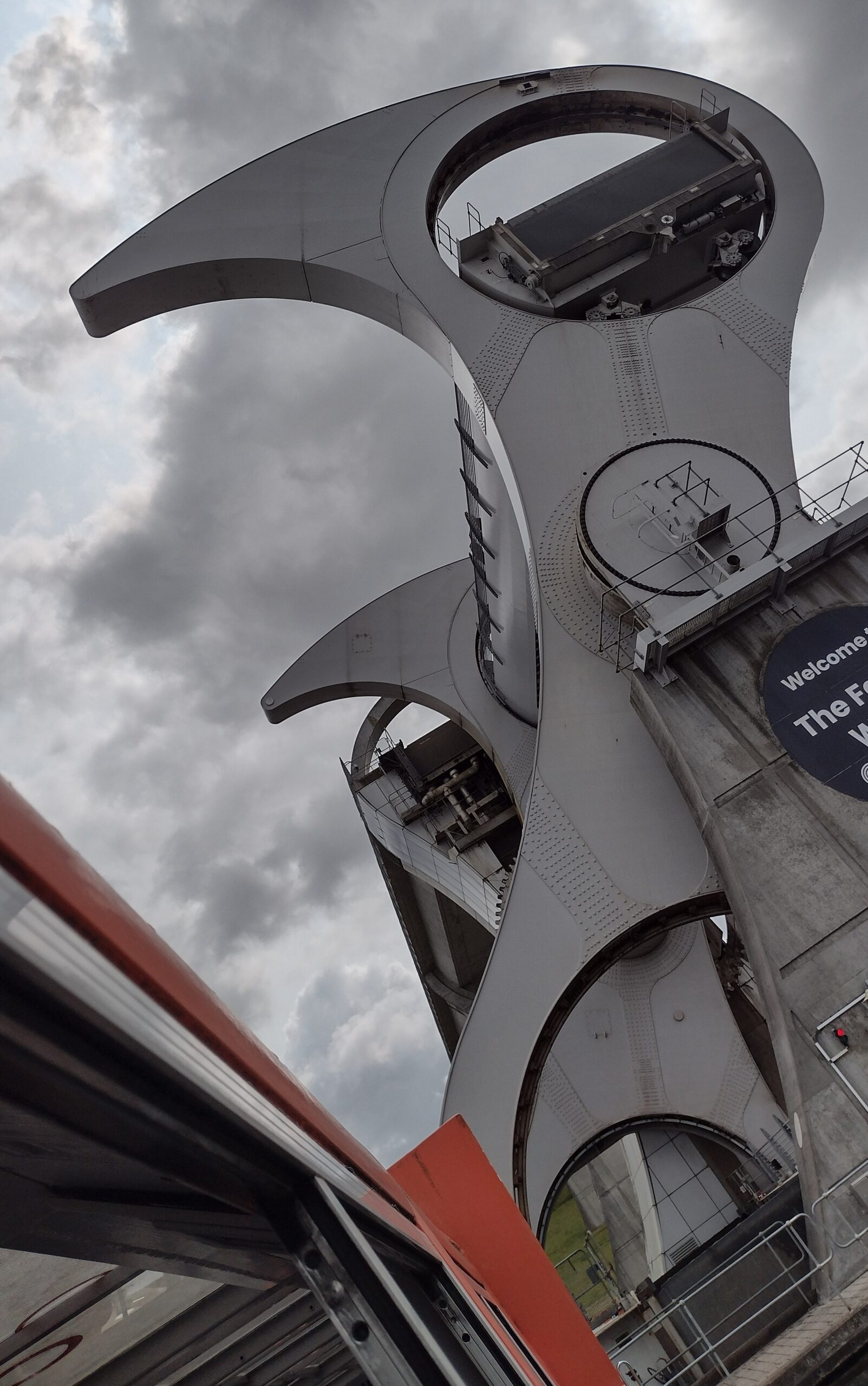
The Falkirk Wheel taken from the sightseeing boat while going in and the other basin with water at the top.
Fast forward to the late 1990s a gentleman called Tony Kettle (it was a team effort of a lot of disciplines, but he had the “lightbulb moment”) came up with the idea to design a new contraption to make this 135 feet drop easier and faster for narrow boats to navigate. The basic idea was to use the weight of water in two boxes and on the Archimedes principle that the weight in each box would always remains the same, regardless of what was put in it. So if the box is just full of water and nothing else in, the weight remains the same if a boat comes in, as the boat displaces the same weight of water as the volume of the boat. That means that only a little push is enough for the top box to go down and the down box to come up.
So we all got a ticket for the 14.20 departure and with a full house, approx. 200 people in the barge, the wheel slowly tipped at the top and started coming down with the top box and we in the lower box went up. The lady skipper gave a sort narration and once at the top we sailed through an 180 meter long tunnel to a turning basin and then came back for the downwards part. At the moment the turning basin is the end of the top bit as it should connect to the Union Canal but that has been drained, so the locks and canal walls can be restored. By end 2026 everything should be fully connected again.
Once down we could see the turning basin that is used for the sightseeing barges to line for loading and unloading, but there are also the locks to connect the turning basin to the Forth & Clyde Canal. The whole drive behind the idea was to create also a lasting monument to Queen Elizabeth’s II sixty years on the throne in 2002. They managed to get it ready and indeed Her Majesty came to take care of the opening. A complete little tourist attraction has since sprung up around the Wheel with a very nice Visitors center (with very expensive souvenirs) and some other activities for children and adults alike. Quite peculiar was the number of German visitors, I have not seen such a large concentration in other locations. But I agree with them it is worth the visit.
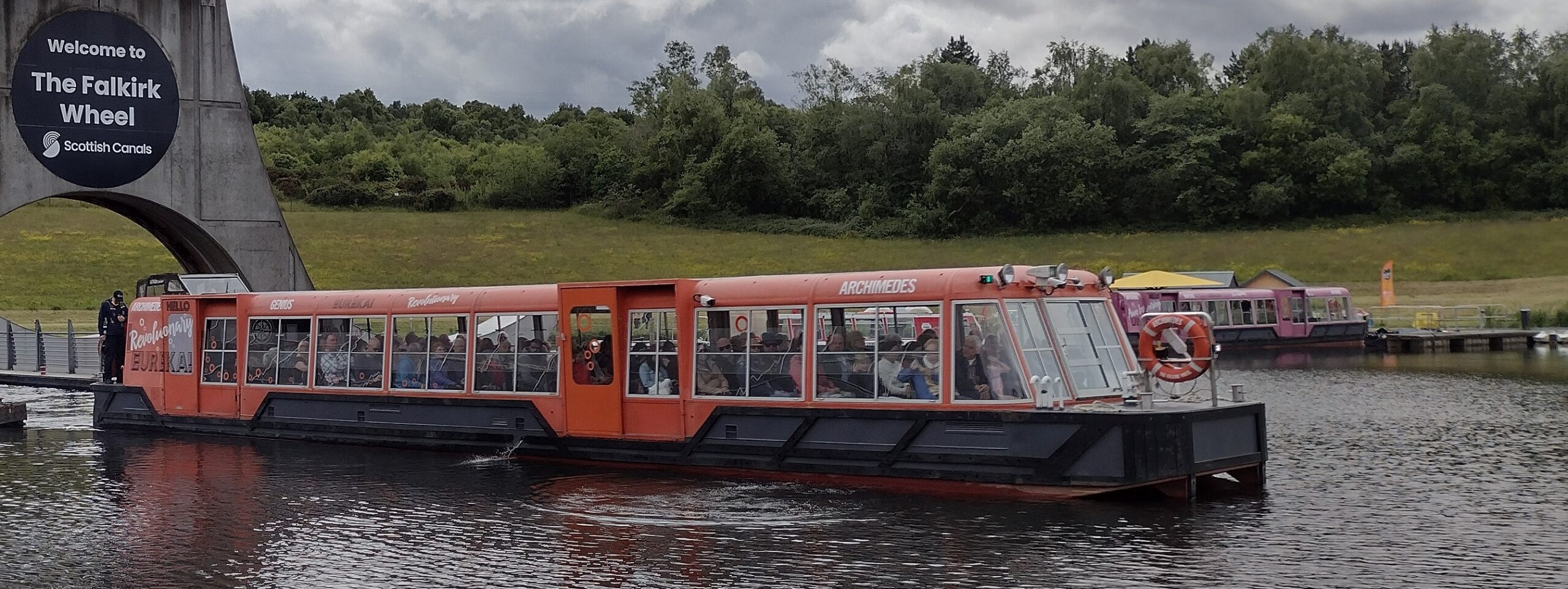
One of the two sightseeing boats or barges. Capacity about 200 people and full all day.
Then it was back with the coach, with the initial promise made that we would drive past the Kelpies. The horses out of Scottish Mythology, immortalized in 2014 in stainless steel horse heads. When they were constructed there was a lot of “doom saying” about throwing away money urgently needed somewhere else. But was with the Falkirk Wheel, it turned out to be a real boost for the local economy. However the bus company had forgotten that today was the final day of “Lloyds cycling Tour of Britain Women” which included 5 rounds in the city and for that purpose part of the ring road was closed off. That realization obviously dawned at the last minute and the bus driver had to take the “high road” instead if the “low road”, while we were already in “Kelpie mood”.
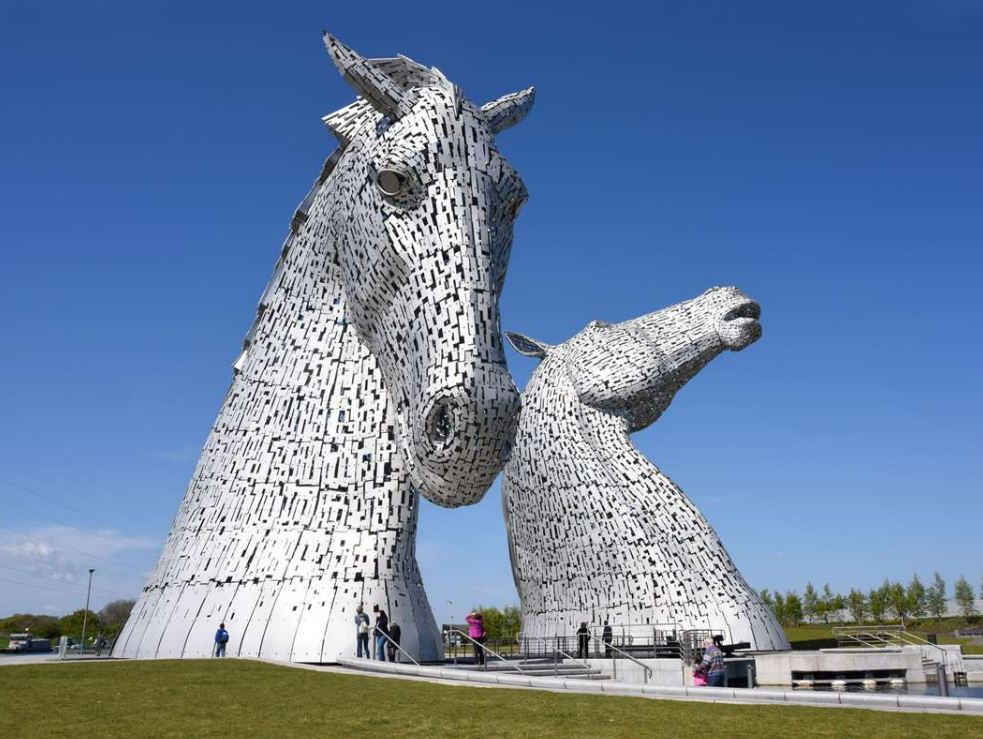
The world famous Kelpies, not this time, maybe next time.
By 1700 we were back at the ship, just in time for cocktails and dinner. We decided to go back to the Canaletto. Again the food was nice, the service friendly but spotty. Tomorrow we are in D’un Laoghaire, which is pronounce Dun-Leery. This is the anchor port for Dublin if there is no dock available in Dublin itself. They have a dedicated cruise dock there but it is too small for the Nieuw Statendam and the cargo port gives preference to ferries and cargo ships. Weather for tomorrow: 16oC/61oF (at the most) and a 20% chance of rain.

